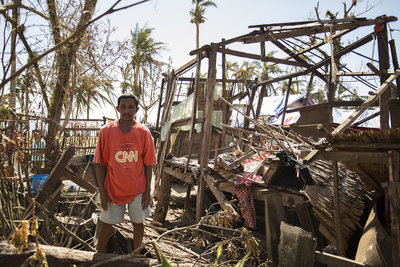
“All my family and I could do was watch the typhoon take our home away,” says Nicomedes Recentes, fisherman from Brgy. Rawis of the municipality of Can-Avid, Eastern Samar. “I’m just grateful that none of my family was hurt.”
Nicomedes’ family is just one of the thousands whose homes were totally damaged by Typhoon Hagupit (Ruby). According to the data of the National Disaster Risk Reduction & Management Council (NDRMMC), as of 14 December 2014 the year’s most intense tropical cyclone affected over 3 million people in all typhoon affected regions.
Packing sustained winds of 160 kph near the center and gustiness of up to 195kph, Typhoon Ruby displaced scores of families forcing them to take temporary shelter in evacuation centers and seek refuge in their own barangays through the support of their local communities.
Immediate post-typhoon challenges on health
Barangay Rawis is just one of the many hard-hit barangays in the northern municipalities of Eastern Samar. Apart from being harder to reach with narrow roads and its isolated location, the small coastal barangay has suffered the province-wide unavailability of electricity which has greatly affected water supply in typhoon-hit communities. This has also posed a challenge to cold chain integrity in barangay health stations where access to essential medicines is especially crucial.
On top of this, families who have completely lost their homes are also exposed to a variety of health risks such as poor sanitation from the loss of proper facilities, dehydration and diarrhoeal disease from a compromised water supply and a wide range of non-communicable diseases from the loss of proper shelter and sustenance.
WHO's support to the Typhoon Ruby response
In its immediate response, the WHO has closely coordinated with the Department of Health and the Provincial Health Office to support disease surveillance and information management across all typhoon-ravaged areas. As of 10 December 2014, the WHO has supported the Department of Health in re-activating SPEED – a mobile-based disease monitoring and reporting system - in provincial operation centers.
“Although the typhoon was weaker than typhoon Haiyan, it has still impacted families and health systems across the several regions. With the flooding, damaged health facilities, and multiple evacuation centers, there are a number of public health risks which will need to be addressed over the coming weeks." said the WHO Country Representative in the Philippines Dr Julie Hall.
The WHO has also helped in assessing health facility damage and the delivery of essential medicines and equipment to affected areas. In its continuing support to the Department of Health and the Provincial Health Office, the WHO has shipped additional logistics for the Borongan Operations Center including office equipment, supplemental IEHKs (Interagency Emergency Health Kit) and assorted medicines and supplies.
It’s still a long road to recovery. As the surge of assistance of continues in Ruby-affected areas, the WHO will continue to support the Department of Health and provincial health offices in the ongoing health response. The WHO is committed to help ensure that public health risks are averted, the health system is supported and health issues surrounding affected populations are timely and efficiently addressed.
